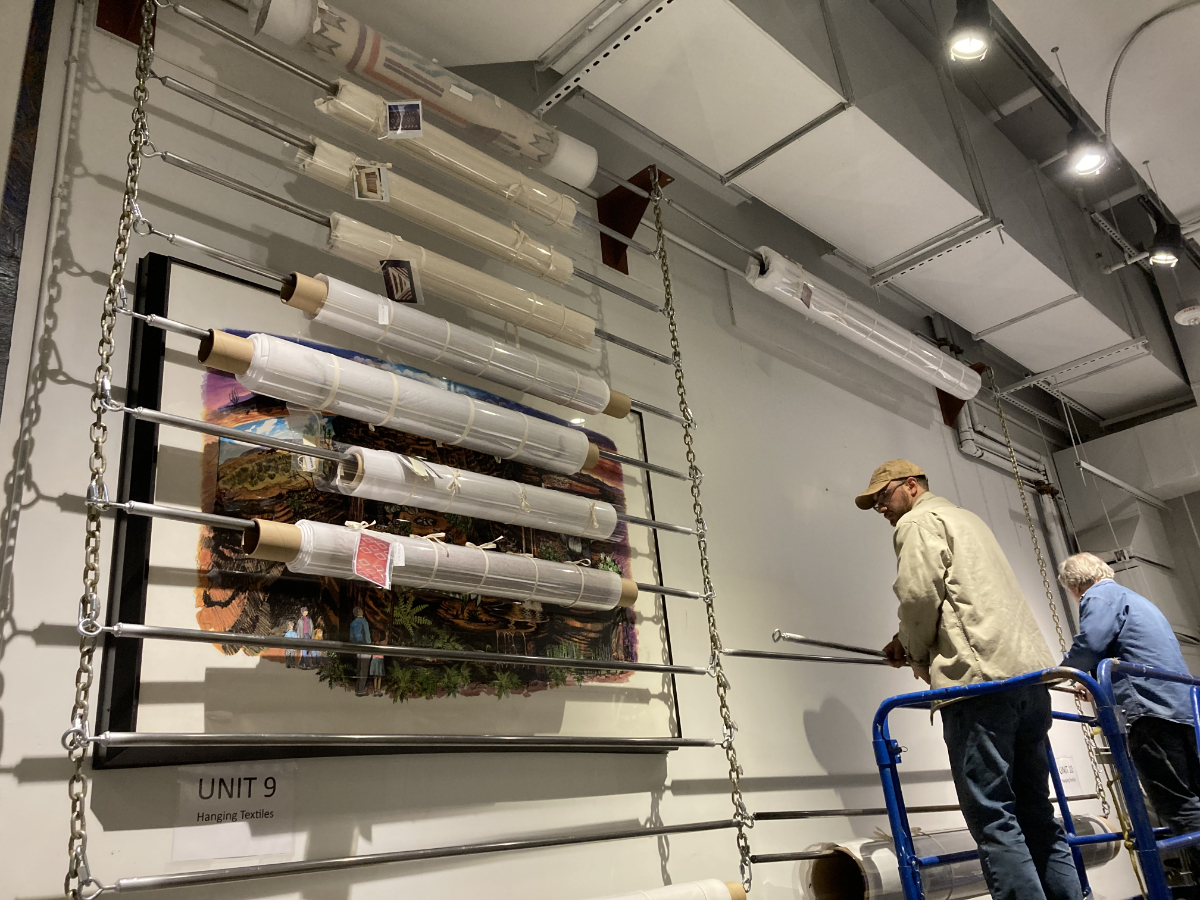The Arizona Museum of Natural History (AzMNH) Anthropology Department was excited to be chosen for the Conserv Preservation Award to re-house several ethnographic textiles in 2023.
Award funding was used to purchase archival quality materials to roll the textiles according to best museum practices. This was an essential project that improved storage of textiles previously folded, housed with off-gassing materials, or those with deteriorating conditions exposing the textiles to light and dust.
The award sparked interest in the project and AzMNH’s Exhibits Department partnered with the Anthropology Department to create custom hanging storage to safely house the newly rolled textiles.
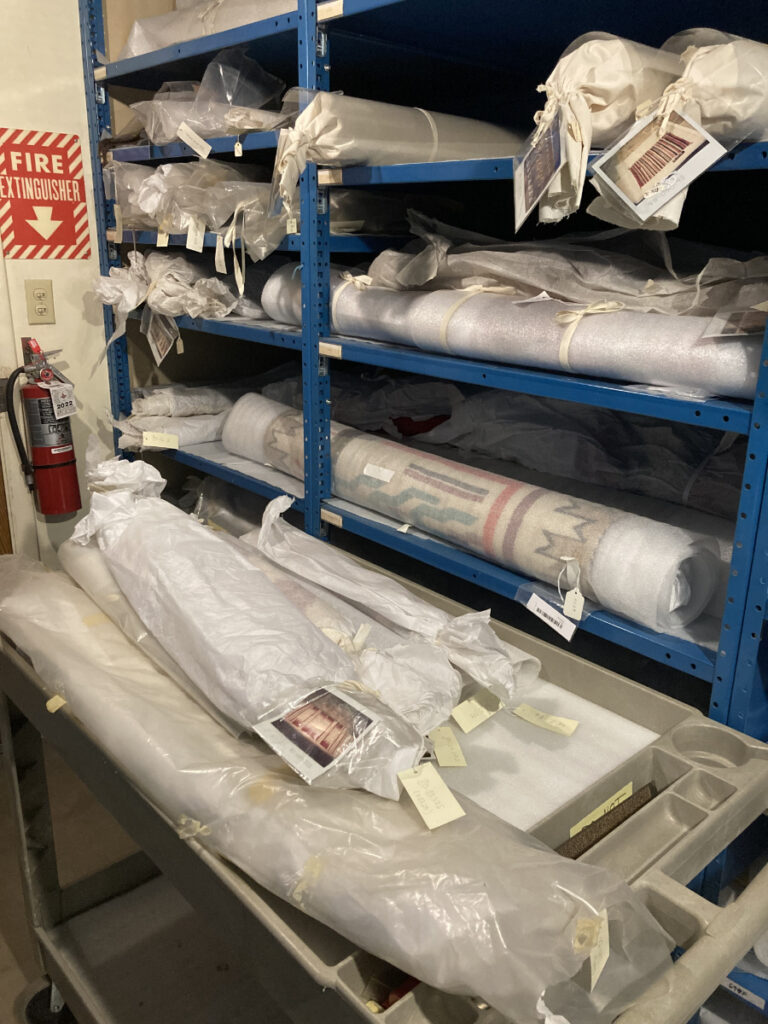
Textile storage before the funded project exhibiting less than ideal materials and rolling methods. Image courtesy of the Arizona Museum of Natural History.
AzMNH textile collection
AzMNH’s Anthropology Department currently cares for nearly 100 textiles representing cultures from the U.S. Southwest, Mexico, and South America. Many of these were donated in the 1980s or 90s and many have remained mostly stagnant in storage since their accessioning.
A large majority of the textiles rehoused for this project were Navajo rugs, especially because oversized textiles were prioritized for rolling and hanging. The largest of these objects was a 12 ft x 9 ft Navajo rug and the oldest piece rehoused was from the 1880s.

One of the larger Navajo rugs in the AzMNH collection with volunteer Caitlyn for size. Image courtesy of the Arizona Museum of Natural History.
The science of rolled textile storage
Textiles are among the most fragile objects cared for at AzMNH. Improperly stored textiles can weaken fibers and lead to breaks in the thread or yarn. Ideally, all textiles would be stored flat, but space restrictions do not always allow this.
Rolling textiles on tubes is an excellent alternative as pressure is distributed evenly around the textile and does not create creases. Once on the tube, a rod is placed inside, and the textile is hung.
Most textiles are good candidates for this process although museum’s housing historic textiles, such as quilts, should seek alternatives as this method can be too stressful on these types of textiles.
Preventive methods for rolled textile storage & conservation
This rehousing project consisted of three main phases: 1) Archival supplies, 2) Rolling rehousing, and 3) Hanging storage.
From start to finish, it took about four months to complete with volunteer assistance.
1. Archival supplies
With Conserv funding, AzMNH was able to purchase archival supplies to roll the textiles (see bullet list below). Funded recipients were also awarded a discount with Gaylord Archival that allowed the funds to go farther.
A majority of AzMNH textiles were not previously housed using museum quality archival products and needed to be completely rehoused. Non-archival materials pose a risk to the objects by off-gassing or yellowing.
Additionally, some textiles in the collection were rolled properly but not covered in a durable cover which caused the tissue exterior to rip and expose the textile to dust and light.
List of archival supplies purchased with the Conserv award at Gaylord Archival
- Cotton Muslin
- Unbuffered acid-free tissue (roll)
- Archival storage tube
- Cotton twill tape
- Unbuffered acid-free tissue (sheets)
- Polyester film (roll)
2. Rolling rehousing
Textile rolling is a method developed in textile conservation for storing large textiles that are too big to be laid flat. This method for rolled textile storage involves carefully applying even pressure while rolling the textile onto an acid free tube and providing padding to textiles that bunch. Finished rolls are covered in muslin or Melinex® to protect the textile from pollutants and light.
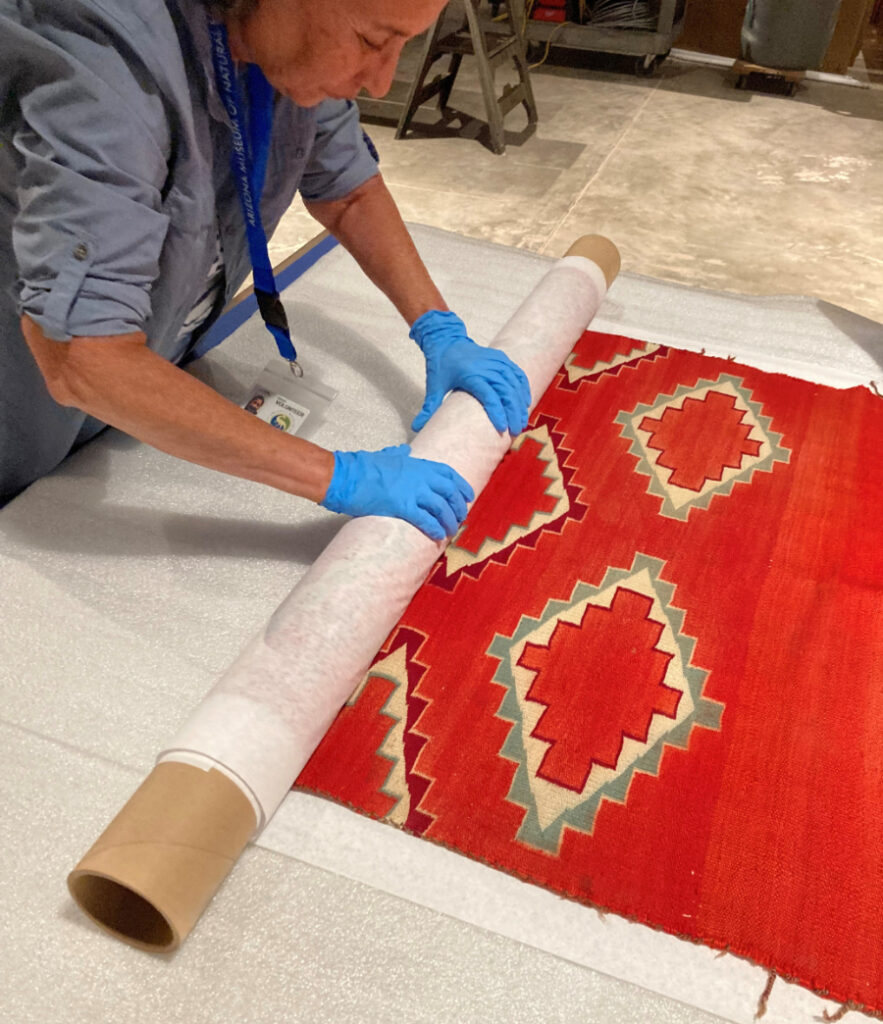
Anthropology volunteer Susan rolling a Navajo serape blanket. Image courtesy of the Arizona Museum of Natural History.
3. Hanging storage
AzMNH’s Anthropology and Exhibits Departments partnered to create custom hanging storage inside the Art Vault (see below). This durable structure utilizes previously unusable space along a high wall.
The team utilized a scissor lift to safely install newly rolled objects. The hanging storage was installed in two sections: one six-foot section and one ten- foot section to accommodate the largest textiles.
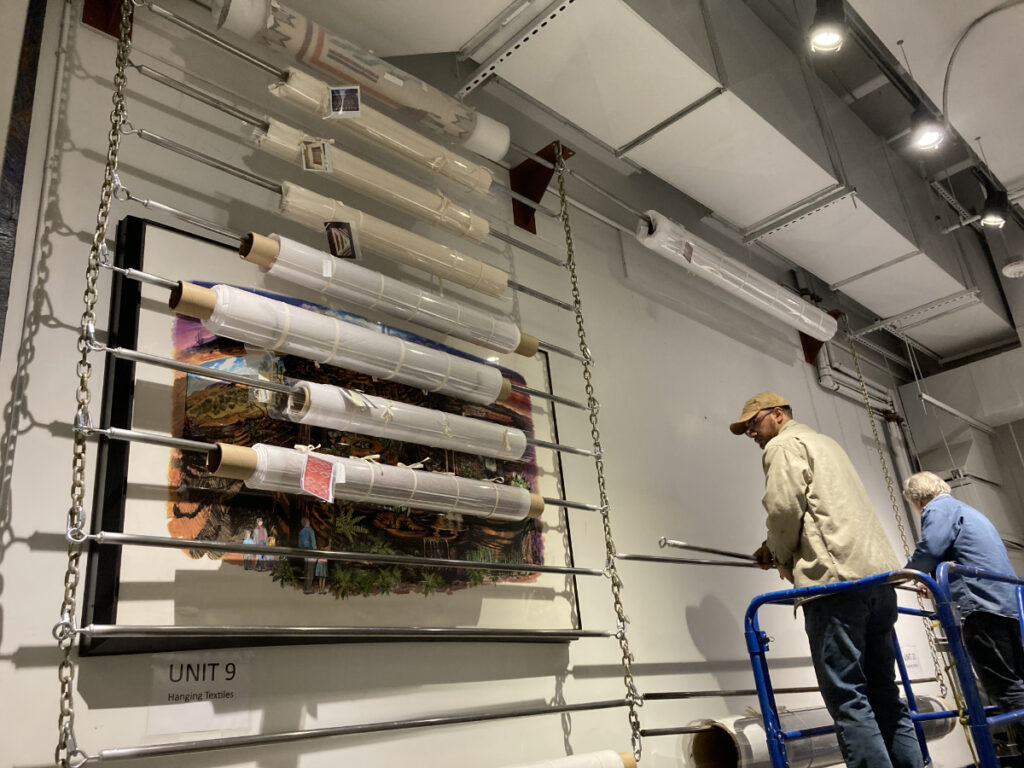
Exhibits Coordinator, Tim (right) and Exhibits Volunteer, Brad (left) install a portion of the new hanging storage. Image courtesy of the Arizona Museum of Natural History.
The Exhibits team used heavy duty equipment to guarantee the heavy textiles would be secure. Brackets were installed on the top and bottom to ensure the chain would not sway. The chain and metal hooks allow the rods to be moved up or down to accommodate varying textile widths.
Hanging storage supplies list
- Steel rod (1” x 0.08” tubing)
- Eyebolts
- Quick links
- Heavy links
- ¼” shackles
- Metal chain
- Locking links
- Flat bar (upper brackets)
- Rectangular tubing (lower brackets)
- Turnbuckles
In the near future, this storage system collaboration will be turned into a PDF guide on how to recreate this storage system for your own museum at a low cost.
Results and takeaways on rolled textile storage
Upon completion of this textile conservation project, 29 textiles were rehoused; over half of the rollable textile collection has been upgraded using archival supplies and museum quality storage. During the process, inventories and catalog records, including object photography, were updated.
All hanging textiles now have a photo and barcode number hanging in an archival bag for easy access and identification. Many textiles had been overlooked since their donations in the 1980s and 1990s and were stored in less-than-ideal ways. These conditions have now been massively improved.
Not only did this project spark a larger rehousing opportunity for hanging storage, but staff and volunteers in the Anthropology Department were able to rehouse smaller textiles (e.g. saddle blankets) inside reused map cases in the same storage room. This storage method is ideal for those that are small enough to be laid flat and allow for easy and safe research engagement without the need to remove the object.
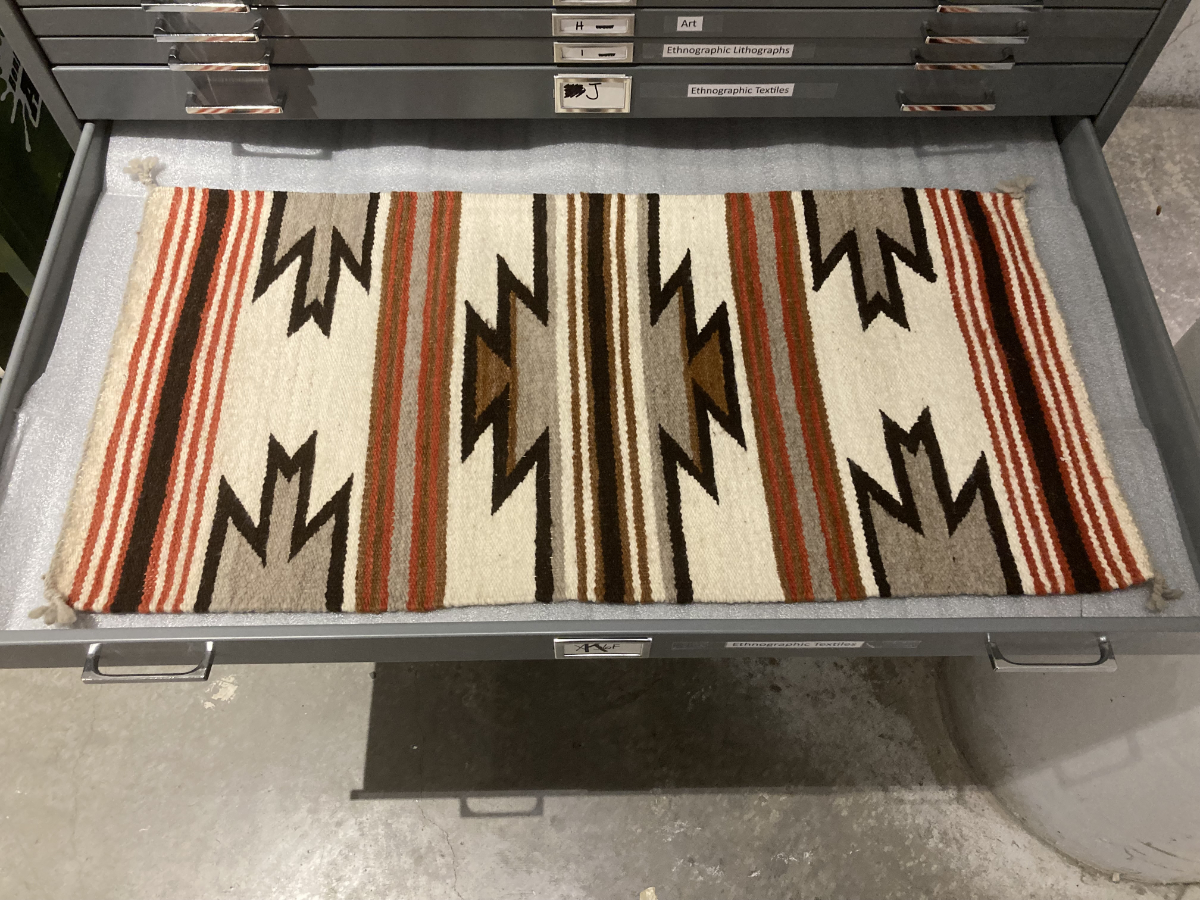
Map cabinets have been repurposed to store small textiles flat. Image courtesy of the Arizona Museum of Natural History.
This initiative has produced a prototype for future conservation and preservation of objects at AzMNH. The textile storage has reinvigorated the Art Vault storage space and is a beautiful example to show off on tours and research visits.
The final project results will be shared during the Conserv Preservation Matters Conference in Washington, D.C. this fall and will include detailed information provided by the AzMNH Exhibits Department on how to recreate this custom storage method at a low cost for any museum.
Acknowledgements
A big thank you to Conserv for supporting preventative conservation awards that has sparked a much larger initiative and conversation at AzMNH.
Additionally, thank you to the large team of volunteers that made this massive project possible. In the Exhibits Department that includes Brad, Matt and Tim and in the Anthropology Department that includes Caitlyn, Elise, Frank, and Susan.
Lastly, this project would not have been possible without the dedication of Tim Walters, Exhibit Coordinator, who designed, custom made, and installed the new hanging storage along with his team.
If you have any questions about environmental monitoring, integrated pest management, or just want to talk about preventative conservation, please reach out to us! Don’t forget to check out our blog or join our community of collections care professionals where you can discuss hot topics, connect with other conservators or even take a course to get familiar with the Conserv platform.

